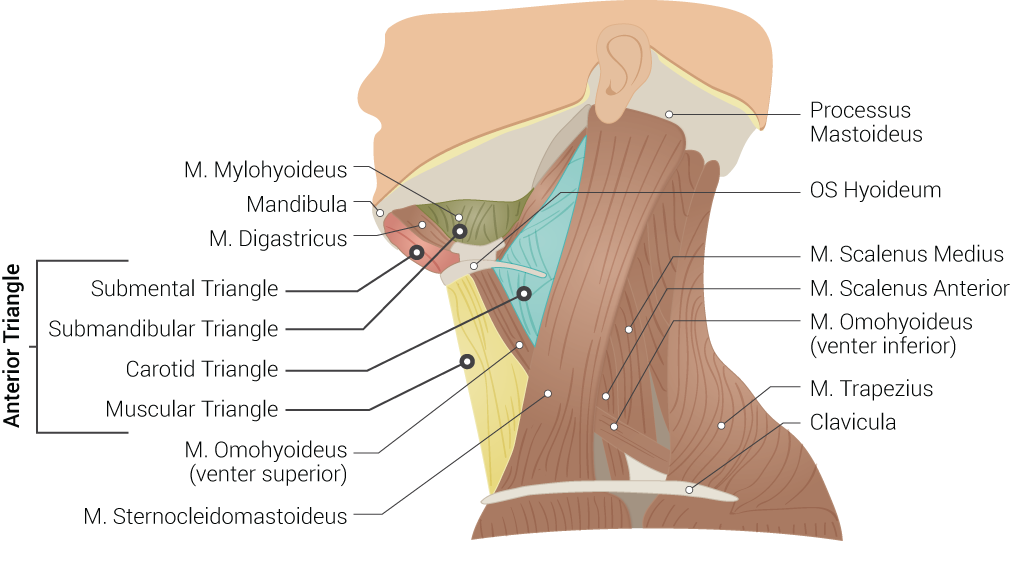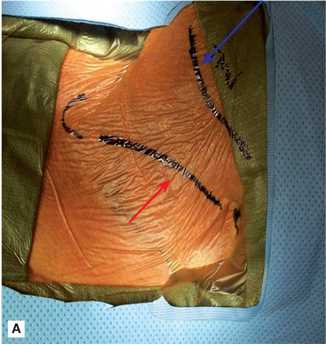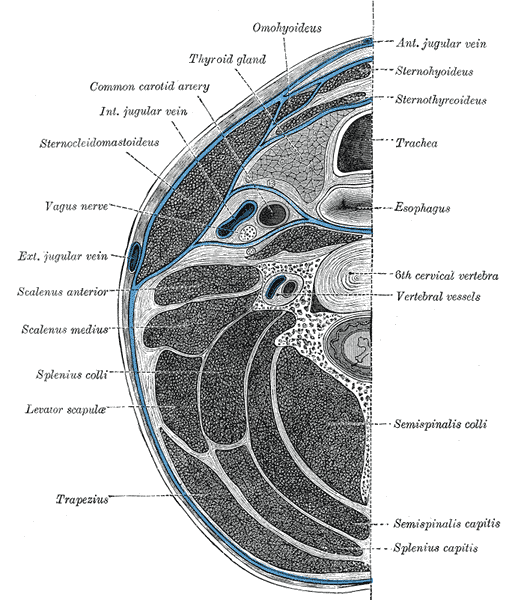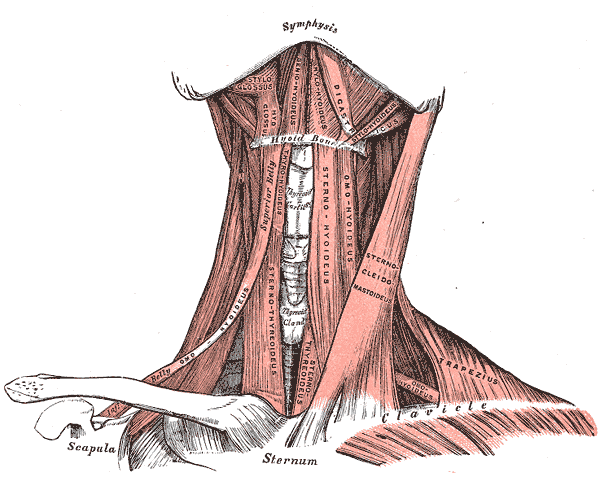[1]
Kohan EJ, Wirth GA. Anatomy of the neck. Clinics in plastic surgery. 2014 Jan:41(1):1-6. doi: 10.1016/j.cps.2013.09.016. Epub
[PubMed PMID: 24295343]
[2]
Kennedy E, Albert M, Nicholson H. The fascicular anatomy and peak force capabilities of the sternocleidomastoid muscle. Surgical and radiologic anatomy : SRA. 2017 Jun:39(6):629-645. doi: 10.1007/s00276-016-1768-9. Epub 2016 Nov 2
[PubMed PMID: 27807639]
[3]
Forbes PA, Fice JB, Siegmund GP, Blouin JS. Electrical Vestibular Stimuli Evoke Robust Muscle Activity in Deep and Superficial Neck Muscles in Humans. Frontiers in neurology. 2018:9():535. doi: 10.3389/fneur.2018.00535. Epub 2018 Jul 5
[PubMed PMID: 30026725]
[4]
Luciani BD, Desmet DM, Alkayyali AA, Leonardis JM, Lipps DB. Identifying the mechanical and neural properties of the sternocleidomastoid muscles. Journal of applied physiology (Bethesda, Md. : 1985). 2018 May 1:124(5):1297-1303. doi: 10.1152/japplphysiol.00892.2017. Epub 2018 Feb 8
[PubMed PMID: 29420159]
[5]
Guo SX, Li BY, Zhang Y, Zhou LJ, Liu L, Widmalm SE, Wang MQ. An electromyographic study on the sequential recruitment of bilateral sternocleidomastoid and masseter muscle activity during gum chewing. Journal of oral rehabilitation. 2017 Aug:44(8):594-601. doi: 10.1111/joor.12527. Epub 2017 Jun 22
[PubMed PMID: 28548212]
[6]
Nooij LS, Oostra RJ. Trapezius aplasia: indications for a dual developmental origin of the trapezius muscle. Clinical anatomy (New York, N.Y.). 2006 Sep:19(6):547-9
[PubMed PMID: 16583429]
[7]
Singh S, Chauhan P, Loh HK, Mehta V, Suri RK. Absence of Posterior Triangle: Clinical and Embryological Perspective. Journal of clinical and diagnostic research : JCDR. 2017 Feb:11(2):AD01-AD02. doi: 10.7860/JCDR/2017/23896.9176. Epub 2017 Feb 1
[PubMed PMID: 28384846]
Level 3 (low-level) evidence
[8]
Lescroart F, Hamou W, Francou A, Théveniau-Ruissy M, Kelly RG, Buckingham M. Clonal analysis reveals a common origin between nonsomite-derived neck muscles and heart myocardium. Proceedings of the National Academy of Sciences of the United States of America. 2015 Feb 3:112(5):1446-51. doi: 10.1073/pnas.1424538112. Epub 2015 Jan 20
[PubMed PMID: 25605943]
[9]
Dominelli PB, Archiza B, Ramsook AH, Mitchell RA, Peters CM, Molgat-Seon Y, Henderson WR, Koehle MS, Boushel R, Sheel AW. Effects of respiratory muscle work on respiratory and locomotor blood flow during exercise. Experimental physiology. 2017 Nov 1:102(11):1535-1547. doi: 10.1113/EP086566. Epub 2017 Sep 24
[PubMed PMID: 28841267]
[10]
Bordoni B, Marelli F, Morabito B, Sacconi B. The indeterminable resilience of the fascial system. Journal of integrative medicine. 2017 Sep:15(5):337-343. doi: 10.1016/S2095-4964(17)60351-0. Epub
[PubMed PMID: 28844209]
[11]
Ciavarella D, Palazzo A, De Lillo A, Lo Russo L, Paduano S, Laino L, Chimenti C, Frezza F, Lo Muzio L. Influence of vision on masticatory muscles function: surface electromyographic evaluation. Annali di stomatologia. 2014 Apr:5(2):61-5
[PubMed PMID: 25002919]
[12]
Miralles R, Valenzuela S, Ramirez P, Santander H, Palazzi C, Ormeño G, Zúñiga C. Visual input effect on EMG activity of sternocleidomastoid and masseter muscles in healthy subjects and in patients with myogenic cranio-cervical-mandibular dysfunction. Cranio : the journal of craniomandibular practice. 1998 Jul:16(3):168-84
[PubMed PMID: 9852810]
[13]
Blouin JS, Siegmund GP, Carpenter MG, Inglis JT. Neural control of superficial and deep neck muscles in humans. Journal of neurophysiology. 2007 Aug:98(2):920-8
[PubMed PMID: 17537909]
[14]
Cvetko E, Karen P, Eržen I. Myosin heavy chain composition of the human sternocleidomastoid muscle. Annals of anatomy = Anatomischer Anzeiger : official organ of the Anatomische Gesellschaft. 2012 Sep:194(5):467-72. doi: 10.1016/j.aanat.2012.05.001. Epub 2012 May 15
[PubMed PMID: 22658700]
[15]
Meznaric M, Eržen I, Karen P, Cvetko E. Effect of ageing on the myosin heavy chain composition of the human sternocleidomastoid muscle. Annals of anatomy = Anatomischer Anzeiger : official organ of the Anatomische Gesellschaft. 2018 Mar:216():95-99. doi: 10.1016/j.aanat.2017.12.001. Epub 2017 Dec 28
[PubMed PMID: 29289708]
[16]
Vajramani A, Witham FM, Richards RH. Congenital unilateral absence of sternocleidomastoid and trapezius muscles: a case report and literature review. Journal of pediatric orthopedics. Part B. 2010 Sep:19(5):462-4. doi: 10.1097/BPB.0b013e32833ce404. Epub
[PubMed PMID: 20647939]
Level 3 (low-level) evidence
[17]
Saha A, Mandal S, Chakraborty S, Bandyopadhyay M. Morphological study of the attachment of sternocleidomastoid muscle. Singapore medical journal. 2014 Jan:55(1):45-7. doi: 10.11622/smedj.2013215. Epub
[PubMed PMID: 24241357]
[18]
Kim SY, Jang HB, Kim J, Yoon SP. Bilateral four heads of the sternocleidomastoid muscle. Surgical and radiologic anatomy : SRA. 2015 Sep:37(7):871-3. doi: 10.1007/s00276-014-1397-0. Epub 2014 Nov 25
[PubMed PMID: 25422097]
[19]
Sarikcioglu L, Donmez BO, Ozkan O. Cleidooccipital muscle: an anomalous muscle in the neck region. Folia morphologica. 2001 Nov:60(4):347-9
[PubMed PMID: 11770348]
[20]
Blythe JN, Matharu J, Reuther WJ, Brennan PA. Innervation of the lower third of the sternocleidomastoid muscle by the ansa cervicalis through the C1 descendens hypoglossal branch: a previously unreported anatomical variant. The British journal of oral & maxillofacial surgery. 2015 May:53(5):470-1. doi: 10.1016/j.bjoms.2015.01.005. Epub 2015 Mar 6
[PubMed PMID: 25747248]
[21]
Cvetko E. Sternocleidomastoid muscle additionally innervated by the facial nerve: case report and review of the literature. Anatomical science international. 2015 Jan:90(1):54-6. doi: 10.1007/s12565-013-0224-8. Epub 2013 Dec 18
[PubMed PMID: 24347311]
Level 3 (low-level) evidence
[22]
Sanabria A, Kowalski LP, Bradley PJ, Hartl DM, Bradford CR, de Bree R, Rinaldo A, Ferlito A. Sternocleidomastoid muscle flap in preventing Frey's syndrome after parotidectomy: a systematic review. Head & neck. 2012 Apr:34(4):589-98. doi: 10.1002/hed.21722. Epub 2011 Apr 5
[PubMed PMID: 21472880]
Level 1 (high-level) evidence
[23]
Kierner AC, Zelenka I, Gstoettner W. The sternocleidomastoid flap--its indications and limitations. The Laryngoscope. 2001 Dec:111(12):2201-4
[PubMed PMID: 11802026]
[24]
Lim KS, Shim JS, Lee YS. Is sternocleidomastoid muscle release effective in adults with neglected congenital muscular torticollis? Clinical orthopaedics and related research. 2014 Apr:472(4):1271-8. doi: 10.1007/s11999-013-3388-6. Epub 2013 Nov 21
[PubMed PMID: 24258687]
[25]
Lee JK, Moon HJ, Park MS, Yoo WJ, Choi IH, Cho TJ. Change of craniofacial deformity after sternocleidomastoid muscle release in pediatric patients with congenital muscular torticollis. The Journal of bone and joint surgery. American volume. 2012 Jul 3:94(13):e93. doi: 10.2106/JBJS.K.01567. Epub
[PubMed PMID: 22760394]
[26]
Pombo Castro M, Luaces Rey R, Vázquez Mahía I, López-Cedrún Cembranos JL. Congenital muscular torticollis in adult patients: literature review and a case report using a harmonic scalpel. Journal of oral and maxillofacial surgery : official journal of the American Association of Oral and Maxillofacial Surgeons. 2014 Feb:72(2):396-401. doi: 10.1016/j.joms.2013.08.017. Epub 2013 Oct 16
[PubMed PMID: 24139297]
Level 3 (low-level) evidence
[27]
Bordoni B, Reed RR, Tadi P, Varacallo M. Neuroanatomy, Cranial Nerve 11 (Accessory). StatPearls. 2023 Jan:():
[PubMed PMID: 29939544]
[28]
Tomczak KK, Rosman NP. Torticollis. Journal of child neurology. 2013 Mar:28(3):365-78. doi: 10.1177/0883073812469294. Epub 2012 Dec 26
[PubMed PMID: 23271760]
[29]
Bourne M, Talkad A, Varacallo M. Anatomy, Bony Pelvis and Lower Limb, Foot Fascia. StatPearls. 2023 Jan:():
[PubMed PMID: 30252299]
[31]
Williams CM, James AM, Tran T. Metatarsus adductus: development of a non-surgical treatment pathway. Journal of paediatrics and child health. 2013 Sep:49(9):E428-33. doi: 10.1111/jpc.12219. Epub 2013 May 6
[PubMed PMID: 23647850]
[32]
Akbari MR, Khorrami-Nejad M, Kangari H, Akbarzadeh Baghban A, Ranjbar Pazouki M. Ocular Abnormal Head Posture: A Literature Review. Journal of current ophthalmology. 2021 Oct-Dec:33(4):379-387. doi: 10.4103/joco.joco_114_20. Epub 2022 Jan 6
[PubMed PMID: 35128182]
[33]
Ganos C, Edwards MJ, Bhatia KP. The Phenomenology of Functional (Psychogenic) Dystonia. Movement disorders clinical practice. 2014 Apr:1(1):36-44. doi: 10.1002/mdc3.12013. Epub 2014 Apr 10
[PubMed PMID: 30363921]
[34]
Carenzio G, Carlisi E, Morani I, Tinelli C, Barak M, Bejor M, Dalla Toffola E. Early rehabilitation treatment in newborns with congenital muscular torticollis. European journal of physical and rehabilitation medicine. 2015 Oct:51(5):539-45
[PubMed PMID: 25692687]
[35]
Van Looveren E, Cagnie B, Coppieters I, Meeus M, De Pauw R. Changes in Muscle Morphology in Female Chronic Neck Pain Patients Using Magnetic Resonance Imaging. Spine. 2021 May 15:46(10):638-648. doi: 10.1097/BRS.0000000000003856. Epub
[PubMed PMID: 33290364]
[36]
Büyükturan B, Şaş S, Kararti C, Büyükturan Ö. The effects of combined sternocleidomastoid muscle stretching and massage on pain, disability, endurance, kinesiophobia, and range of motion in individuals with chronic neck pain: A randomized, single-blind study. Musculoskeletal science & practice. 2021 Oct:55():102417. doi: 10.1016/j.msksp.2021.102417. Epub 2021 Jun 12
[PubMed PMID: 34147954]
Level 1 (high-level) evidence
[37]
Choi KH, Kwon OS, Kim L, Lee SM, Jerng UM, Jung J. Electromyographic changes in masseter and sternocleidomastoid muscles can be applied to diagnose of temporomandibular disorders: An observational study. Integrative medicine research. 2021 Dec:10(4):100732. doi: 10.1016/j.imr.2021.100732. Epub 2021 May 16
[PubMed PMID: 34141576]
Level 2 (mid-level) evidence
[38]
Paul FA, Buser BR. Osteopathic manipulative treatment applications for the emergency department patient. The Journal of the American Osteopathic Association. 1996 Jul:96(7):403-9
[PubMed PMID: 8758873]
[39]
Galindez-Ibarbengoetxea X, Setuain I, Ramírez-Velez R, Andersen LL, González-Izal M, Jauregi A, Izquierdo M. Immediate Effects of Osteopathic Treatment Versus Therapeutic Exercise on Patients With Chronic Cervical Pain. Alternative therapies in health and medicine. 2018 May:24(3):24-32
[PubMed PMID: 29135458]
[40]
Marszałek S, Niebudek-Bogusz E, Woźnicka E, Malińska J, Golusiński W, Śliwińska-Kowalska M. Assessment of the influence of osteopathic myofascial techniques on normalization of the vocal tract functions in patients with occupational dysphonia. International journal of occupational medicine and environmental health. 2012 Jun:25(3):225-35. doi: 10.2478/S13382-012-0041-7. Epub 2012 Jun 22
[PubMed PMID: 22729499]





